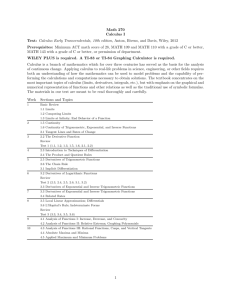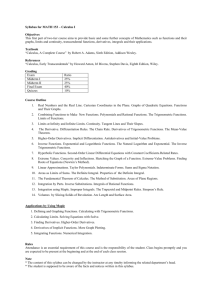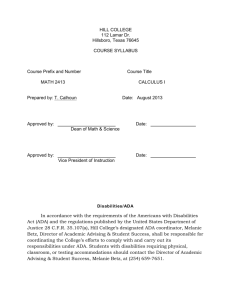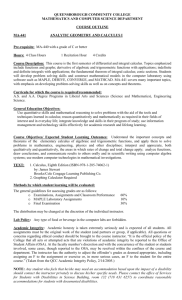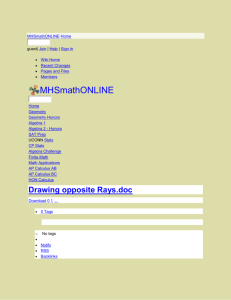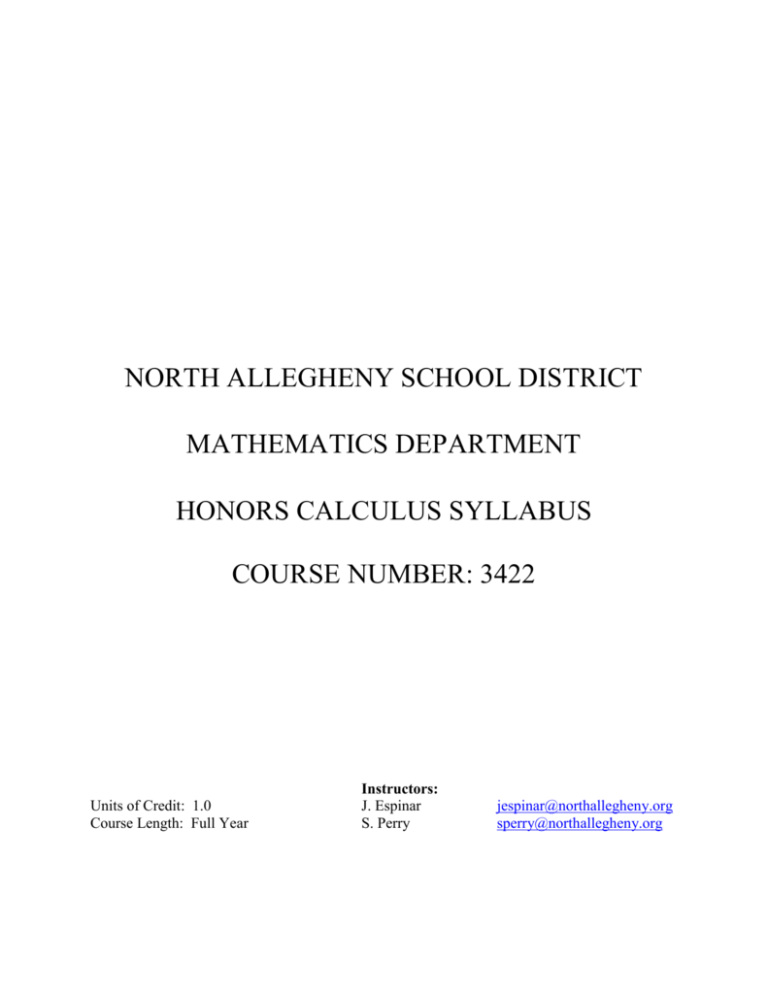
NORTH ALLEGHENY SCHOOL DISTRICT
MATHEMATICS DEPARTMENT
HONORS CALCULUS SYLLABUS
COURSE NUMBER: 3422
Units of Credit: 1.0
Course Length: Full Year
Instructors:
J. Espinar
S. Perry
jespinar@northallegheny.org
sperry@northallegheny.org
Honors Calculus Syllabus
Course Overview
Honors Calculus is a course designated for students who have completed four years of honors
math with a high level of achievement. The topics covered in Honors Calculus make it the
standard first course in a basic calculus sequence required for all mathematics, science,
engineering, and statistics students at the college level. Therefore, students may obtain four
college credits through the University of Pittsburgh College in High School program. The
course emphasizes a multi-representational approach to calculus, with concepts, results, and
problems being expressed in multiple ways: geometrically, numerically, analytically, and
graphically.
Textbook
Finney, Demana, Waits, Kennedy, Calculus: Graphical, Numerical, Algebraic, Boston: Pearson
Prentice Hall, 2007.
Course Outline:
The following topics are covered in Honors Calculus:
Chapter 1: Prerequisites for Calculus
Algebraic Methods Review (lines, absolute value, inequalities)
Functions and Graphs (definitions, properties, notation)
Polynomial and Rational Functions
Exponential and Logarithmic Functions
Trigonometric Functions
Parametrically defined Functions
Chapter 2: Limits and Continuity
Rates of Change and Limits
Limits Involving Infinity
Continuity
Rates of Change and Tangent Lines
Chapter 3: Derivatives
Derivative of a Function
Differentiability
Rules of Differentiation
Motion along a line: position, velocity, acceleration
Derivatives of Trigonometric Functions
Chain Rule
Derivatives of Parametric equations
Implicit Differentiation
Derivatives of Inverse Trigonometric Functions
Derivatives of Exponential and Logarithmic Functions
Logarithmic Differentiation
Chapter 4: Applications of Derivatives
Extreme Values of Functions
Mean Value Theorem
Graphing using the first and second derivative
Modeling and Optimization
Differentials and linear approximation
Newton’s Method
Related Rates
Chapter 5: The Definite Integral
Estimating with Finite Sums
Definite Integrals
Definite Integrals and Antiderivatives
Indefinite integrals: Recover a function from its growth rate (derivative)
Fundamental Theorem of Calculus
Trapezoidal Rule
Chapter 6: Differential Equations and Mathematical Modeling
Area under a curve
Antidifferentiation by Substitution
Antidifferentiation by Parts
Integration of powers of sines and cosines
Exponential Growth and Decay
Logistic Growth
Partial Fraction Decomposition
Chapter 8: L’Hopital’s Rule
L’Hopital’s Rule
Expected levels of student achievement
Course grades will be determined by the collective point totals from assessments, homework,
classroom projects/participation and standardized test preparation assignments. It is expected
that all students will participate in daily classroom activities and maintain a notebook. Students
must complete all assigned work and participate in class discussion.
Technology description
Students are expected to continue to grow in their use of technology. Students are expected to
obtain a graphics calculator. We recommend purchasing from the Texas Instruments TI-84
family of calculators. Students are expected to access online resources and grades.
Standardized Test Preparation
The North Allegheny Mathematics Curriculum is designed to prepare students for standardized
tests while meeting Pennsylvania State Mathematics Standards and Eligible Content. The focus
will be on numbers and operations, algebraic concepts, geometry, data analysis and probability,
and measurement. Students will be expected to complete Open Ended tasks throughout the
course.


